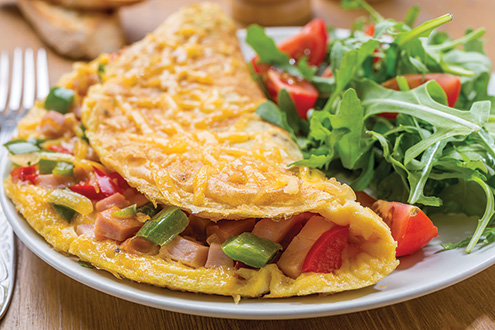Scrambled. Boiled. Over-easy. Fried. No matter how you serve them, eggs can be a delicious choice for any meal of the day. But what exactly makes an egg so special? Let’s crack the code on egg chemistry and see what makes an egg, well … an egg.
SHELL
Egg shell is composed mostly of calcium carbonate. On the shell, there are thousands of pores that allow for the exchange of gases, much like our lungs exchange gas. The shell also contains a “bloom” and a “cuticle,” which help to prevent bacteria from entering the egg. This layer is often washed off during commercial egg production, which is why eggs sold in stores must be refrigerated. Hobby chicken farmers often don’t wash their eggs, allowing them to be stored on the counter since they still have the bloom and cuticle present.
MEMBRANES
There are inner and outer membranes that offer more protection against bacteria entering the egg, and these contain keratin – the same protein in human hair!
AIR CELL
The air cell is located on the rounded end of the egg (opposite the “pointy” end). This is noticeable when you peel a boiled egg and there is an indention in the bottom. When an egg is laid, it is hot off the press! Once it cools, the air cell is created as the egg takes up oxygen. This means the older the egg, the larger and more pronounced the air cell will be.
ALBUMEN
This is what we call the egg white. This part comprises most of the weight of the egg and contains most of the protein. As eggs age, this “white” gets clearer, which is due to the initial carbon dioxide content of a young egg that causes the white part to be opaque but gets clearer as more carbon dioxide is pushed out of the shell.
YOLK
The runny yellow/orange center is the heart of the egg. This is what provides all the nutrients to the growing embryo. If you crack an egg open, you will see a white spot on the yolk, known as the germinal disc. The germinal disc is how you can tell whether the egg has been fertilized. A fertilized egg has a germinal disc that looks like a circle with a clear center, showcasing the male and female cells. This is the embryo and what will be the future chick. The non-fertilized germinal disc will only contain the female cells and will look like a solid white spot. The entire yolk contains vitamins, minerals, calcium and protein.
CHALAZAE
The chalazae are the stringy bands you see when you crack an egg open. These fibrous bands hold the yolk in the center of the shell. The fresher the egg, the more noticeable the chalazae are. They will start to fade in color as the egg ages and look more like part of the egg white.
Eggs are one of the most nutritious foods on earth, so eat up! Be sure to cook your eggs to the recommended temperature of 145-165 degrees, and remember to speak with your doctor or registered dietitian to determine how to safely include eggs in your diet. You also can visit www.USDA.gov for more information on egg safety.
That’s all yolks!
Answering other egg-cellent questions
ARE BROWN EGGS BETTER FOR YOU?
Eggs come in many different colors and sizes. Brown eggs and white eggs are both great nutritional choices. Neither shell color nor size indicate an egg’s nutritional value; however, the hen’s diet and environment can have an effect on some nutrients, which would be noticeable in the yolk color. Hens who have access to sunlight and eat a diet rich in certain nutrients, along with certain insects, will lay eggs with a darker, orange-colored yolk. A lighter yellow yolk can mean that hen’s diet was heavy in cornmeal and processed barley. Both egg yolk colors have tons of nutrients and are “eggscellent” choices.
HOW ARE EGGS GRADED?
You may have noticed that eggs are “graded.” The USDA mandates this system, with grades ranging from AA, A, and B. These grades are based on the condition of the shell and the quality of the white. Egg grading is done by “candling” the eggs, which means they are placed over a light source to view the shell integrity, air cell size and yolk placement and to look for blood spots and other defects.
GREEN EGGS, NO HAM
Why do some boiled eggs have green around the yolk? This is a chemical reaction from the sulfur in the white and the iron in the yolk. It may not be pleasant to the eye, but it is harmless and indicates the egg was boiled for too long or at too hot a temperature.



